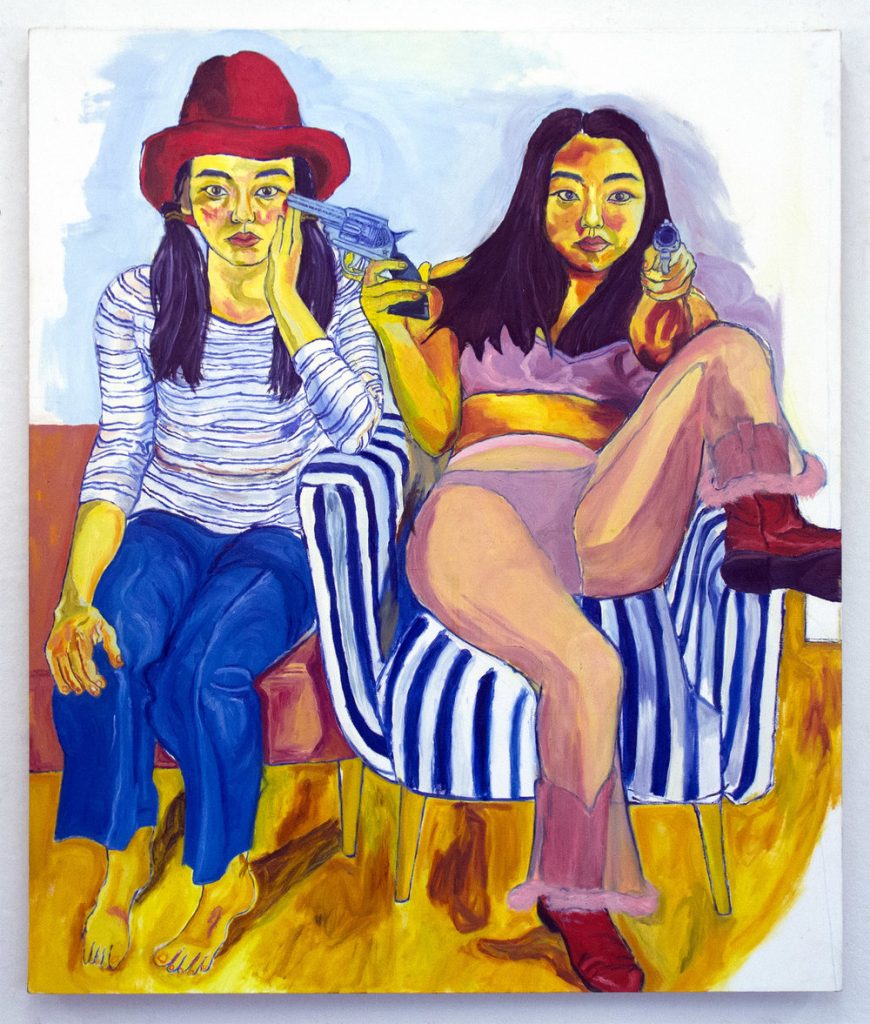
Christine Cho is interested in “the power of the collective (people and images) and performativity’s relation to personal and historical narratives.” There is no doubt that Christine’s work is in conversation with what it means to be visible — the two characters in “Do Si Do” confront the viewer with direct eye contact, and one even holds the viewer at gunpoint. But Christine’s work goes beyond just acknowledging the viewer. It also requires the viewer’s response to the questions she poses about performance and reality in relation to the United States and South Korea.
The painting’s title, “Do Si Do,” refers to a square-dancing call, a circular movement in which two people walk around each other. Square-dancing has long been associated with the romanticization of cowboys and the “Old West.” In “Do Si Do,” the idea of circling around one another is not unlike a “Wild West” showdown, in which two gunslingers “face off” and duel. This Americana act of dueling to establish dominance over another creates two characters: “the opponent” and “the hero.” The hero character, the “White American” (cowboy) is central to upholding the fragile American consciousness and creating the idea of an “other.” The “Korean Cowgirl” in “Do Si Do” is a character that Christine developed in response to her childhood experiences of being born and raised in Houston, Texas.
In her decision to appear twice on the canvas, Christine references the duality (or multiplicity) of intersectional identities, which often manifests through the practice of code–switching. The Christine on the left seems to represent the passive, or perhaps complacent performance expected of an Asian appearing woman in everyday American society, versus, the Christine on the right who fights this reality as an Asian American woman. In “Do Si Do,” Christine uses her own life to threaten the viewer to interrupt her internal conflict. Christine asks us to confront this reality and hold ourselves accountable for it.
Christine challenges the Western canon of art, specifically the genre of oil painting, which has been exalted in the United States as a high medium of “Western Art.” In reappropriating the imagery of women artists like Maria Lassnig and Alice Neel, Christine calls out the histories of white feminism in the United States that have continually failed to make space for those at the intersections of minority populations.
Artist and activist Skye Volmar reminds us too that “although non-black people of color are working to untangle that history, black femmes bear the biggest burden of that marginalization.” Skye explains that both historically and presently, the United States inflicts oppression and violence through the colonial erasure of the intersectional narratives “of all marginalized folx at all intersections of ability, class, gender, sexuality and race.” Here it upholds singular definitions of Western classical and contemporary art. Painting allows Christine to develop her own visual language in order to better understand and combat these notions of performativity, and how they relate to her everyday experiences as a Korean American. Christine explains, “In these constructed painterly spaces, I am able to reimagine and play out realities that center myself. I do not have to justify my right to belong and can invite others who identify with the work, to imagine themselves inhabiting these spaces as well. The work is an extension of my body — tangible moments with physical presence that stand in my place when I am not present.”
Christine Cho is a Korean American artist and curator from Houston, Texas. She graduated from the Rhode Island School of Design in 2019, where she earned a BFA in painting and is currently working and living in Providence. In January, Christine will travel to South Korea on a Fulbright US Student Grant to further investigate the relationship between visibility, performance and South Korea’s traditional uses of mediums through painting. In her own words, Christine Cho dreams of “reimagining the future with friends and wants to better understand people through their narratives.” For more images of Christine’s work, visit her website: christinehcho.com
